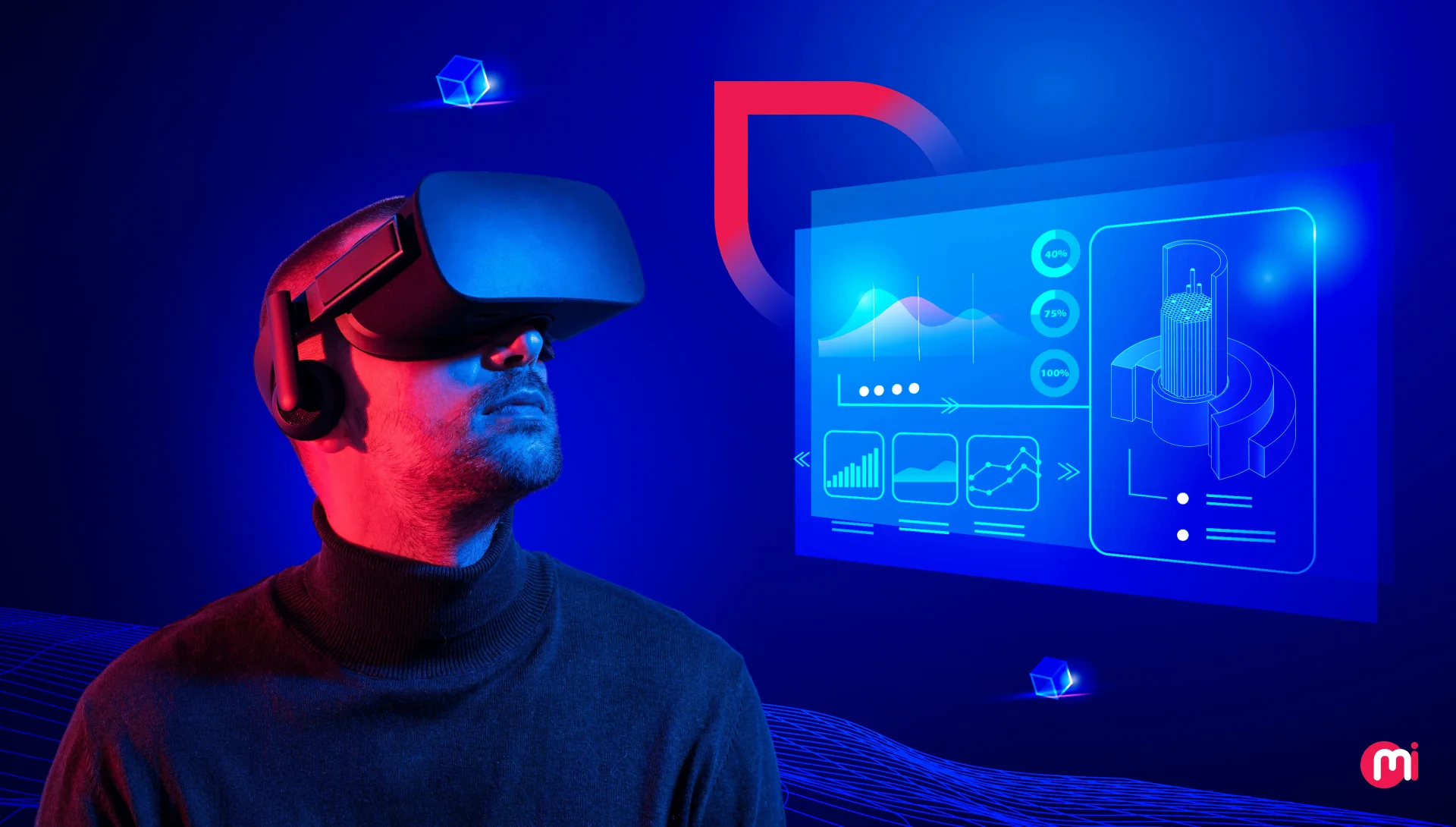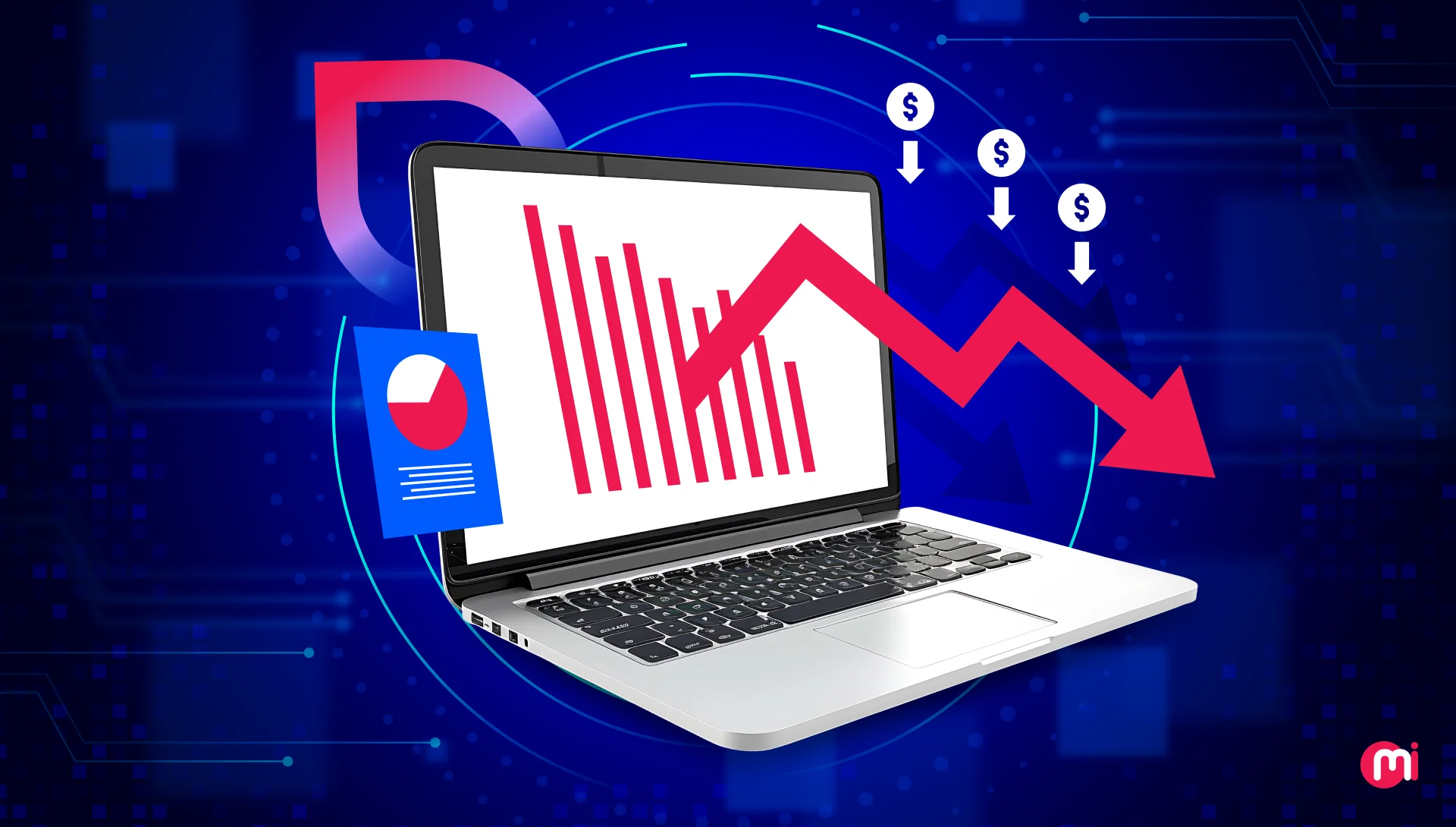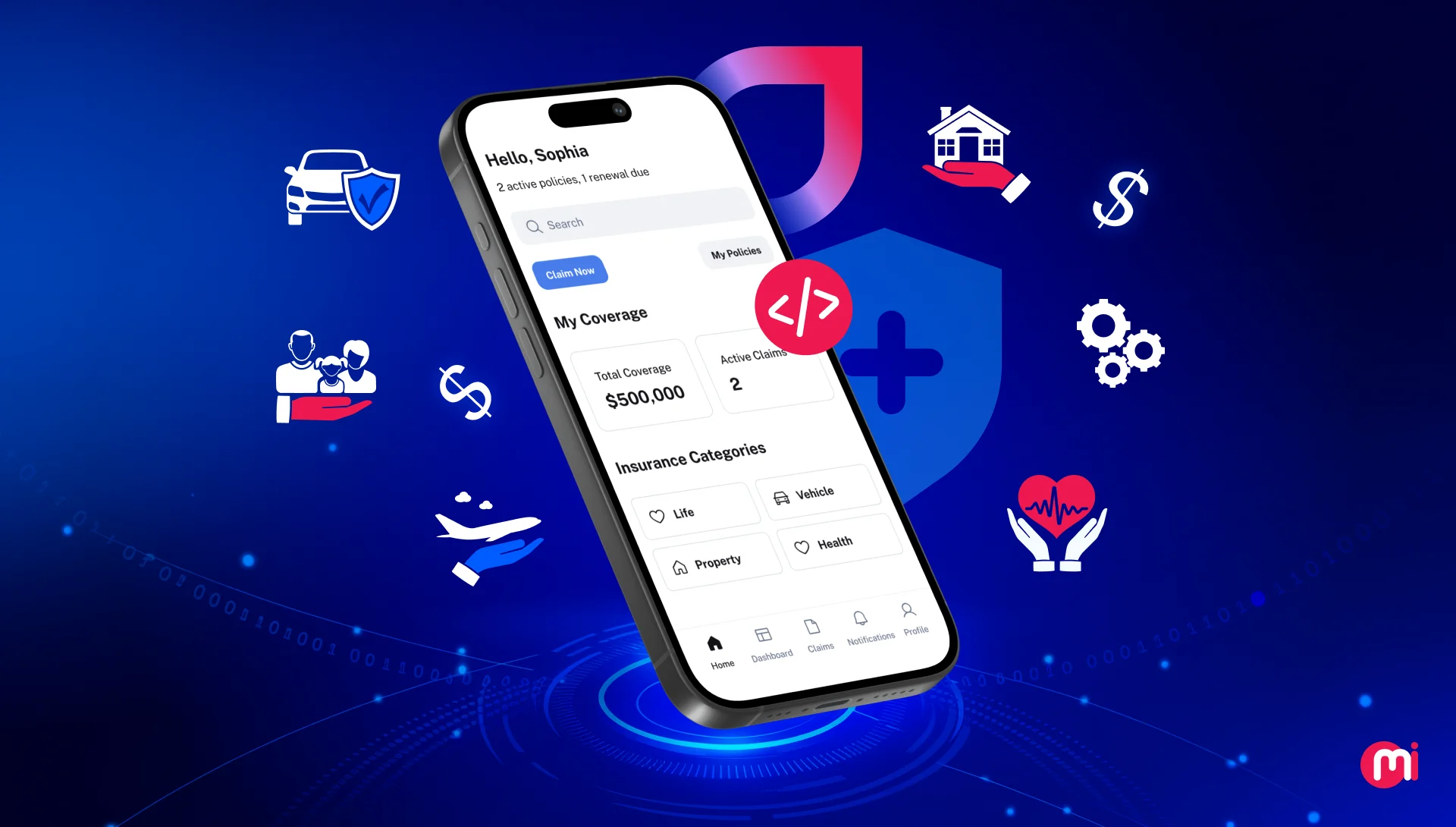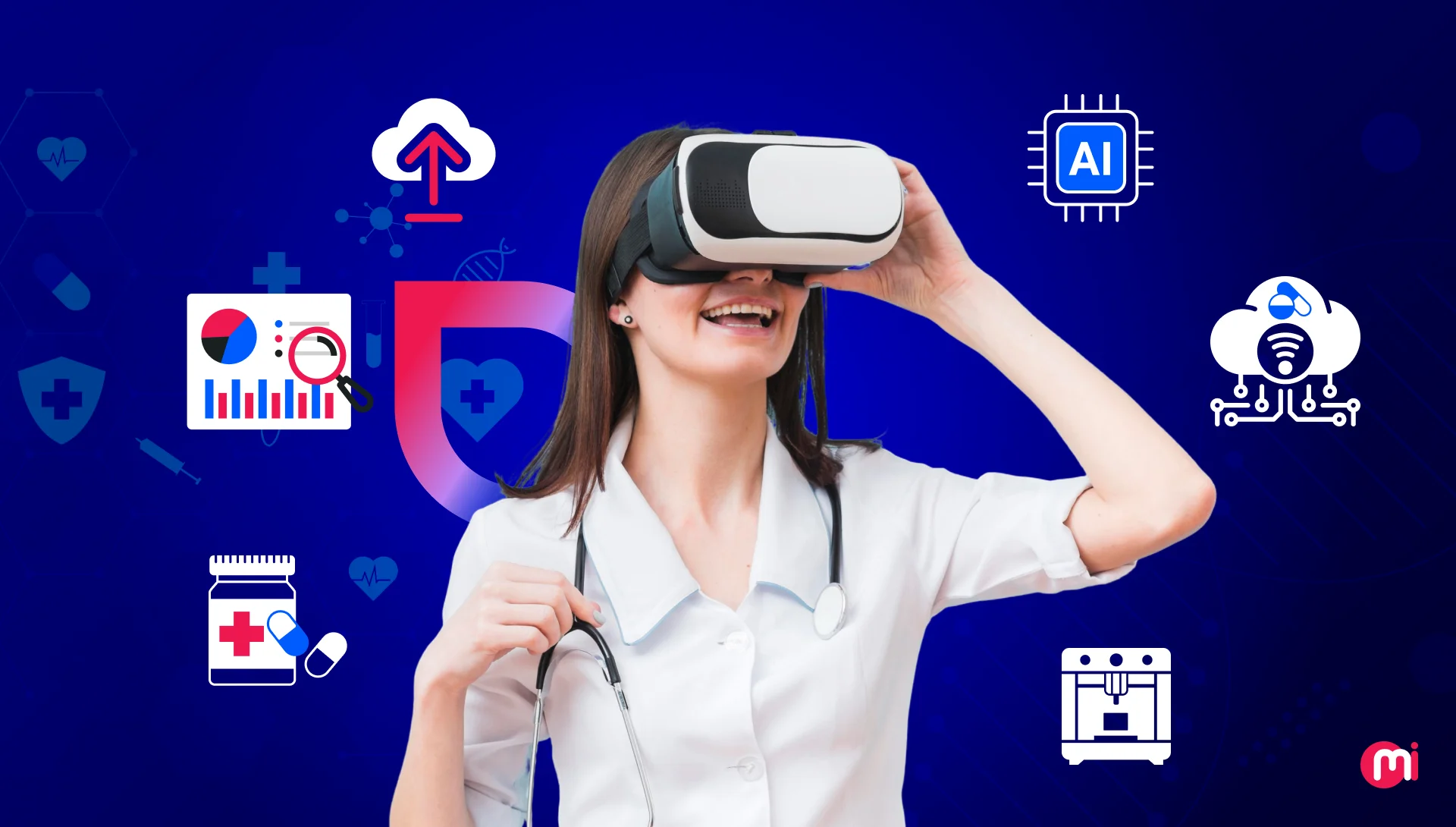Digital Twin Applications and Real-world Examples Across Industries
- Business
- September 30, 2025
Think digital twin is a technology of the future? But the facts suggest otherwise!
Digital twins have been around longer than many of us realize. The idea of Digital Twin was first used with the name “living models” at NASA in the 1960s.
One of the most notable uses in history was during the Apollo 13 mission, where a digital twin helped forensic analysts determine the manufacturing fault that caused the oxygen tank explosion. This event has become a landmark example of the power of digital twins, capturing the imagination of tech enthusiasts ever since.
And that’s just one instance. In this blog, we’ll explore many other real-world examples of how digital twins are transforming industries.
Key Takeaways
- Wide adoption of digital twins shows they are now mainstream across industries.
- Their role extends beyond efficiency; they cut costs, improve experiences, and reduce risks.
- Case studies from Tesla, BMW, Walmart, and HSBC highlight proven, real-world impact.
- The top digital twin use cases range from 3D design and simulation in automotive to fraud detection and liquidity management in finance, proving their versatility.
- Early adopters of digital twins position themselves for stronger competitiveness in the future.
What Are Digital Twins?
Digital twins are virtual, real-time replicas of physical objects, processes, systems, or environments that leverage real-world data and AI/ML solutions to test the model by simulating situations to predict outcomes and provide strategies/solutions to resolve them.
You can say that a digital twin technology solution can work as per your changing requirements in scenarios.
Types of Digital Twins
Some of the popular types of digital twins include component twins, asset twins, system twins, and process twins.
Read further to know what these digital twin types are and what they provide:
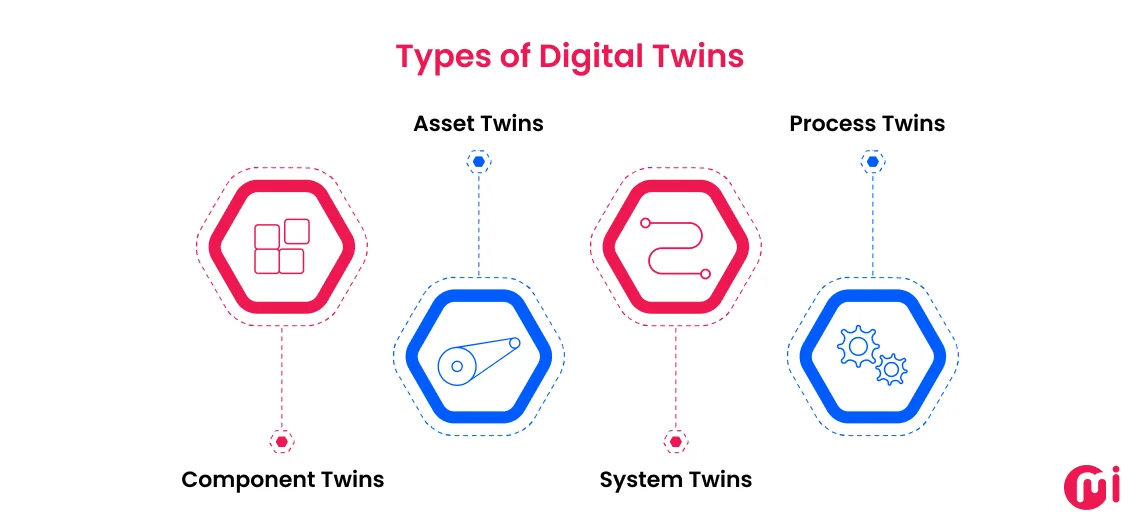
1. Component Twins
It is the smallest unit of a digital twin, representing an individual part or component of a system (e.g., a motor or sensor).
It allows detailed monitoring and analysis of the specific component’s performance and condition.
2. Asset Twins
This represents an entire asset, made up of multiple components. For example, a digital twin of a car, machine, or turbine.
It provides insights into how different components work together and how the entire asset is performing as a whole.
3. System Twins
It represents a system of multiple assets working together. For example, an HVAC system in a building or a production line in a factory.
It helps optimize how assets interact, improving overall system efficiency and identifying potential problems between interconnected components.
4. Process Twins
It creates a digital representation of the working of an entire system. For example, manufacturing, logistics, or supply chain operations.
It allows companies to simulate and optimize complex processes, predict outcomes, and make data-driven decisions to improve efficiency and reduce risks, leveraging AI development services.
Read Also: What Do CTOs Need To Know About Digital Twin Technology?
Why Should You Invest In Digital Twins?
Investing in digital twins can benefit you in terms of embracing innovation, saving costs related to post-development traps, having a backup of a backup, and making the right use of data.
Digital twins have emerged as a crucial technology that every enterprise-level business should invest in, regardless of the industry.
To truly grasp the importance of this technology, it’s essential to first identify the challenges your business may face in the future. Digital twins offer a proactive solution by allowing you to stay ahead of potential problems, providing insights that help you address issues before they arise.
Below are the key reasons why your business should consider investing in digital twins:
Because You Don’t Want to Miss Out On Innovation Opportunities
As digital twin technology helps to simulate real-world processes and assets, it enables you to experiment with new ideas, optimize designs, and innovate faster without the risks or costs associated with real-world trials.
With that approach, digital twins enable you to continuously improve and adapt, ensuring your business remains at the cutting edge of technology and industry advancements.
Because You Don’t Want to Fall For Post-Development Cost Traps
Many businesses face unexpected costs after launching a product or completing a project due to unforeseen issues or inefficiencies.
Digital twins help prevent these cost traps by providing detailed insights throughout the development process, allowing you to identify potential problems early on.
As per a McKinsey survey, digital twins can help to reduce capital expenditures and operating expenditures by 15%.
Because You Don’t Want to Regret Later For Not Having a Backup Plan
There are chances, from the outside view, that things implemented may look sturdy and elegant, but against certain scenarios, such robust things may fall down. This can be the case for any real estate construction that may fall victim to natural disasters.
Considering this, digital twins allow you to simulate potential future scenarios, giving you the ability to prepare for various outcomes. Whether it’s equipment failure, process inefficiencies, or unexpected disruptions, digital twins help you create contingency plans and respond to issues more effectively.
Because You Don’t Want Your Data To Go To Waste
Businesses generate vast amounts of data, but much of it goes underutilized. Why make such valuable data go to waste when you can make the most out of it using data-driven digital twins for a better cause?
Digital twins enable you to make the most of your data by turning it into actionable insights, leveraging data science services. Through real-time monitoring and analysis, digital twins help you optimize operations, predict issues, and make data-driven decisions that enhance performance and efficiency.
Popular Digital Twin Applications Across Industries
Digital twins show adoption and applications across industries, including healthcare, real estate and construction, logistics & supply chain, automotive, retail, and banking & financial services.
Let’s explore digital twin use cases/applications with real-world examples across industries that you’d be interested in exploring:
1. Healthcare
Operations in healthcare are highly dependent on tried-and-tested and case study-based applications. Before putting any treatment through human trials, the industry has to invest heavily in lab tests, resources, and more to get its approval. There are chances that even after investing millions or billions of dollars, the output is not up to the mark and may take months or even years to complete.
That’s where the involvement of digital twins in healthcare industry operations comes as a valuable solution to save time and resources.
Let’s check out ways digital twins in healthcare procedures help:
- Surgical Planning and Simulation: Surgeons can use digital twins to create a 3D replica of a patient’s anatomy, allowing them to plan and rehearse complex surgeries in a risk-free virtual environment. This way, they can improve the accuracy of surgeries, reduce the risk of complications, and enhance patient safety.
- Drug Development and Testing: Pharmaceutical companies can use digital twins to simulate how drugs will respond within human biology, helping to identify potential side effects and optimize drug formulas without the need for extensive physical trials.
- Chronic Disease Management: Digital twins can continuously monitor patients with chronic conditions, using real-time data from wearables to predict disease flare-ups and optimize treatment regimens. Here, data engineering services can help significantly.
- Training and Education: Digital twins can also be implemented for medical institutes and research facilities to help students practice medical procedures and diagnose conditions in a virtual environment that mimics real-world scenarios. This provides hands-on learning opportunities in a controlled, risk-free environment, improving skills and confidence.
When talking about real-life examples of digital twins being used in healthcare, the cardiology section is leading the way, with big industry players like Siemens Healthineers, Dassault Systèmes, and Philips found investing in this technology.
These companies are developing digital twins of human hearts to simulate their behavior with pacemakers, the reaction with new drugs, and the mechanical responses of the hearts during surgeries.
2. Real Estate & Construction
When it comes to real estate, construction, and architectural project planning, there are several critical factors that businesses must consider. These include sustainability, team collaboration, procurement processes, and many other aspects.
Moreover, in architectural planning, detailing present in static 2D and 3D designs can often get lost in translation. This can complicate rendering and pose safety challenges during development.
Leveraging AI in real estate can help, but to simulate certain scenarios, it needs digital twin capabilities. They help firms avoid costly mistakes by offering various solutions, such as:
- Safe Infrastructure Planning: Digital twins allow architects and designers to create detailed virtual 3D models of buildings and infrastructure. These models can be used to run simulations for various scenarios, such as earthquakes of different intensities, fire outbreaks, flood events, and other potential risks, to have a solution for such scenarios from the planning stage.
But are these virtual 3D models the same as virtual staging in real estate? Read the guide to know better.
- Predictive Maintenance and Asset Management: After construction, digital twins can be used to monitor building systems, such as HVAC, lighting, and security. By analyzing real-time data, these models help identify maintenance needs before they become critical issues. This proactive approach to maintenance reduces downtime, extends the lifespan of building systems, and lowers operational costs.
- Urban Planning: In urban planning, digital twins are used to create dynamic, real-time digital replicas of cities or regions. These models allow planners to simulate and analyze various urban scenarios, such as traffic flow, energy consumption, infrastructure development, and environmental impact. Digital twins enable city planners to optimize land use, manage resources efficiently, and predict the effects of new developments.
Check out how we helped our client create a digital twin of a flood in the city, allowing them to prepare the rescue plan:
Real-world examples show digital twin technology is widely used in real estate. For instance, SHoP Architects and JDS Development Group use 3D digital modeling, similar to digital twins, to track construction progress and effectively manage development costs and carbon footprints.
Similarly, developers of DAMAC Properties, Perkins&Will, London Heathrow Airport, and the LAX Project have applied digital twin technology to enhance infrastructure quality.

3. Logistics & Supply Chain
Businesses in the supply chain and logistics have to deal with time and ensure on-time demand and delivery of goods. However, the complexities of paperwork, unwanted situations, and many delays affect operations. Digital twins can help to optimize critical logistics and supply chain operations. It does that by:
- Enhancing Shipment Protection: Companies can leverage a digital twin to simulate techniques of package handling and packaging conditions during transportation and find effective ways to manage shipments and deliver packages in their original condition.
- Packaging Quality Testing: There are different proven techniques for packing orders, like using sturdy cardboard boxes, plastic film, foil pouches, woven sacks, paper bags, glass, and more. Still, due to some unexpected and unavoidable situations, these packages get damaged, and so do the goods. Digital twins can virtualize different packaging for specific goods, test it in different unavoidable conditions, and more to identify potential packaging errors and determine packaging material feasibility.
- Logistics Network Creation: In logistics & supply chain, efficient and safe deliveries of shipments are end goals. It can be impacted by supply routes. Digital twins can be used in this operation to create models for different routes to test them with different geographical conditions, traffic situations, road layouts, construction, and more to optimize route planning from inventory and warehouses to delivery locations. This not only helps to deliver shipments faster but also in the safest way.
| FUN FACT:Another way to leverage digital twins for better outcomes is by creating a data twin. There couldn’t be a better example than Google Maps, which is a digital twin of the Earth’s surface, providing proactive insights about planned routes. The insights include real-time data about traffic, crashes, lane closures, slowdowns, construction, objects on the road, flooded roads, and low visibility. |
4. Automotive
Digital twins are used extensively in the automotive sector. It not only helps to design the vehicle for better speed but also helps to build better ones. Its work doesn’t just end with building; it also helps simulate scenarios to test the build quality of the vehicle in different scenarios and perform better in those, too.
Using digital twins in the automobile sector saves you time and money and provides better opportunities to innovate.
Top use cases of digital twin in automotive include
- 3D Car Design and Development: This is highly useful for car manufacturing companies that are into developing luxurious and racing cars. Digital Twin leveraging data not only helps design better car aerodynamics but also configure wheel drive systems (such as front-wheel drive, rear-wheel drive, or all-wheel drive) for better stability.
- Self-Driving Car Development: It’s not only time-consuming but also costly if you follow the traditional testing approach. Leveraging digital twin in this, you can not only simulate its function across different road driving possibilities but also harness its training and testing data to improve its performance and reliability.
Tesla, BMW, Mercedes-Benz, Ford, General Motors (GM), Toyota, Renault, and Volvo use digital twin technology for various applications. Some of the popular use cases include designing and testing new components and vehicles, simulating manufacturing processes, monitoring performance, and optimizing operations throughout the product lifecycle.
5. Retail
The digital transformation in retail has indeed revolutionized the way customers shop from retailers. But to enhance the customer journey, both online and offline, and even in an omnichannel setting, building a digital solution isn’t enough. Retailers need digital twins to improve customer engagement and their shopping experience.
Some tech-savvy retailers have even started leveraging digital twins to enhance customers’ digital and in-store shopping experiences.
They are embracing the top use cases of digital twins in retail:
- Store Designing and Planning: Many retail stores, specifically supermarkets and hypermarkets, are leveraging digital twins to optimize physical store planning by leveraging insights from customer behaviors and challenges while navigating the space. This way, retailers can also make the most of their store spaces, which delivers better business outcomes.
- Operations: Digital twins of SKUs and stores enable a wide range of applications that enhance operational efficiency, from autonomous checkout to intelligent in-store.
- Customer Modeling & Simulation: In retail, understanding customers is the biggest task. This asks for thinking about multiple preferences of ideal customers. Digital twins help simulate those personalities and their preferences, leading to delivering an exceptional customer experience. For example, a clothing brand outlet can leverage a digital twin to cater to different customer segments that convert into sales.
Big retail brands, like Walmart, Nike, Adidas, IKEA, Lowe’s, and Starbucks, leverage digital twins for various purposes, such as optimizing store operations and layouts, managing supply chains, and enhancing the customer experience both online and in-store.
6. Banking & Finance
With nearly 96% of Americans relying on digital banking & finance software to manage their accounts and financial activities, banks have started to be proactive in safeguarding their sensitive information and delivering them a better online banking experience.
Along with complying with industry standards to safeguard their digital services, many financial institutions are also considering using digital twins to improve resilience, operational efficiency, and customer trust.
They are leveraging digital twins to simulate real-time scenarios, forecast risks, and test new business models with precision.
Top use cases of digital twins in banking & finance include:
- Cash Flow & Liquidity Management: Banks and financial institutions use digital twins of their cash reserves, ATMs, and liquidity positions to forecast demand, manage cash distribution, and reduce idle capital. This ensures optimal liquidity while lowering operational costs.
- Revenue Growth & Portfolio Optimization: By creating digital twins of customer segments, portfolios, or even entire business units, banks can simulate different strategies to increase revenues. This helps in better decision-making on pricing, cross-selling, and investment planning.
- Cognitive Contract Automation: Financial institutions are leveraging digital twins of contracts and agreements to automate compliance, track obligations, and reduce legal risks. This not only cuts administrative overheads but also minimizes human errors in contract execution.
- Fraud Detection & Risk Simulation: Digital twins enable banks to model potential fraud patterns and stress-test their systems against various risk scenarios. This helps strengthen cybersecurity measures, regulatory compliance, and overall financial safety.
- Customer Experience Modeling: Similar to retail, digital twins in banking simulate customer behaviors, preferences, and transaction journeys. This allows banks to design more intuitive services, from personalized loan products to streamlined mobile banking experiences.
Leading financial institutions like Atom Bank, JP Morgan, HSBC, DBS Bank, and Standard Chartered are already experimenting with digital twin technology to monitor operations, improve risk management, optimize branch networks, and elevate customer experiences.
5 Real-World Examples of Digital Twins Across Industries
Digital Twins is not a theoretical tech; it has practical, real-world applications, and top firms like Siemens Healthineers, London Heathrow Airport, Tesla, Lowe’s, and Atom Bank, among others, prove that.
So, let’s check out popular real-world examples of digital twins:
1. Siemens Healthineers
Siemens Healthineers is a German multinational company specializing in medical technology. Partnering with Harapan Kuta National Cardiovascular Center Hospital, it identified an innovative approach to create patient replicas. This experiment is helping them to early detect diseases, plan personalized treatment, predict health risks, and simulate scenarios.
2. London Heathrow Airport
London’s Heathrow Airport implemented digital twins technology to reduce CO₂ emissions by 30,000 tonnes annually.
It first analyzes real-time airport ground staff operations, such as aircraft movement, fueling stations, passenger flows, baggage handling, and more. Leveraging these data, it utilizes digital twins to simulate scenarios, which helps optimize ground operations, smartly manage air traffic, achieve energy efficiency, and ensure sustainability.
3. Tesla
Tesla is an American multinational automotive and clean energy company. It has created digital twins of its car, which collect real-time data of cars across different scenarios. The data it collects include battery health, energy output, temperature, environmental data, sensor data, and more.
Tesla uses these real-time digital twin data to predict maintenance needs, improve vehicle performance, and offer Over the air (OTA) software updates.
4. Lowe’s
To drive innovation and enhance operational performance, U.S. home improvement retailer Lowe’s has leveraged its Innovation Labs to build digital replicas of its 1,700 stores. These digital twins combine spatial data, product locations, and order histories, updated multiple times a day with AI support.
Employees use AR headsets to visualize these twins in real time, enabling tasks like shelf resets, restocking, and product placement with greater accuracy. Beyond mirroring store layouts, the system enhances operational efficiency, improves employee productivity, and helps localize in-store planning.
5. Atom Bank
UK-based Atom Bank, a digital-only challenger bank, collaborated with Durham University to create a digital twin of its entire banking model. Built on advanced mathematical and statistical methods, the twin helps simulate and optimize critical business decisions, from financial planning and resource allocation to product pricing and funding strategies. This approach gives Atom Bank a data-driven edge in managing operations and scaling efficiently.
How Does MindInventory Help Businesses Implement Digital Twins?
After reading this blog, you must have figured that basically, digital twins technology is a practical enabler of efficiency, innovation, and resilience across industries. From automotive to healthcare to retail, businesses are already witnessing the transformative impact of creating real-time virtual replicas of assets, processes, and customer experiences.
The takeaway is clear: organizations that embrace digital transformation services and digital twins gain sharper insights, faster decision-making capabilities, and a significant competitive edge.
MindInventory, being a digital twins solutions provider, helps you blend AI/ML, data engineering, and cloud app development services to build scalable intelligent ecosystems tailored to your business needs. Whether it’s modeling complex financial systems, simulating customer journeys, or optimizing operations with predictive insights, we ensure that your digital twin strategy translates into measurable business outcomes.
We don’t just talk; we’ve helped our client with the solar planning platform, which is helping planners and homeowners to model solar performance, visualize real-world conditions, and forecast ROI in real time.
We’ve also helped our client create a digital twin of a property, which is enabling their clients to take a virtual property tour, eliminating the need for clients to visit the site and making decisions to purchase the property faster.
Partner with us to:
- Design and deploy custom digital twin frameworks aligned with your enterprise goals.
- Integrate data pipelines from enterprise systems for real-time synchronization.
- Enhance decision-making with predictive analytics and AI-driven simulations.
Scale your digital twin ecosystem securely with cloud engineering services.

FAQs About Digital Twins
Component twins, asset twins, system twins, and process twins are the four types of digital twins, one of which you can adopt as per your application requirements.
A digital twin works by creating a real-time virtual replica of a physical asset or system, using live data from sensors and IoT devices to mirror the physical object’s behavior. This “living” model, fed by continuous, bidirectional data, allows users to monitor performance, predict future outcomes, and test “what-if” scenarios in a virtual environment using AI and machine learning.
The future of digital twin applications will be more around deeper integration with AI and AR technology for more advanced simulations and autonomous insights. This will enable industries to predict, optimize, and manage complex physical systems with greater autonomy.
Moreover, key trends in the digital twin include the rise of “systems twins” and “process twins” for simulating complex interactions and workflows, as well as the development of self-optimizing digital twins that can learn from their own experiences.
The cost to build a digital twin can be somewhere in the range of $50,000 to $500,000 or more. You can expect the variation in the cost to implement digital twins, depending on factors like project scale and complexity, data integration, features and functionalities, software and hardware, and requirements for maintenance and upgrade.
When implementing a digital twin, you can expect to face challenges around data quality, integration, and security due to reliance on vast, sensitive, and often unstructured data from various sources, including legacy systems.
Digital twins have a profound impact across various industries by enabling real-time monitoring, predictive analytics, and improved decision-making. Specifically, they enhance processes, facilitate risk assessment, support precautionary measures, and assist in identifying solutions or causes of issues.
Digital twins are widely adopted to help with strategic project planning, performance optimization, decision-making, and innovation by serving as a virtual representation of physical assets, processes, or systems.
Digital twins are dynamic, real-time, and continuously updated with live data, while simulations are usually static, model-based, and used for testing hypothetical scenarios.
Beyond a 3D representation, a digital twin acts as a dynamic, living model of a real-world entity. In contrast, 3D models are merely visual representations, which may or may not correspond to a real-world entity, and they do not provide real-time data for action.
Though Building Information Modeling (BIM) is a statistical 3D representation of a building’s design and construction details, it cannot be called a digital twin. However, it can be turned into a digital twin by adding sensors to collect real-time data and get insights about the building’s performance.
No, digital twins cannot be called AI, but they often incorporate AI technologies for different applications. When AI is integrated into a digital twin, it can make it smarter and more effective in areas like predictive maintenance and process optimization.
